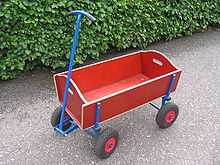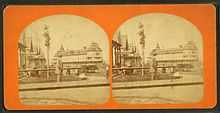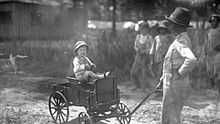Toy wagon

A toy wagon has the same structure as the traditional, larger wagon, but is much smaller and has an open top. An average wagon is able to seat one child, and is generally propelled by human power through a handle at the front. Some famous brands are Radio Flyer, Red Rider, Northern Tool and Equipment, Lowe's, and Speedway Express.
History
Ancient cultures such as the Mayans and the Aztecs had toy carts.
US history

Toy wagons have been around since the late 19th century, and are traditionally painted red. They were originally made of wood. Antonio Pasin started making wagons in 1923 and eventually started the Radio Flyer company. He produced many of them in his workshop in Chicago and they became a national hit after the 1933 Chicago World Fair. His toy wagons helped bring people back from the thoughts of the looming war to their simple pleasures.

Design
The basic design of toy wagons has been the same since the late 19th century. Usually, a small wagon contains 9, 12, or 16 bolts. The back axle usually contains 4 bolts, and the front varies among the different steering designs. The wheels can be air tires, hard rubber tires, or hard plastic tires. Some small kids' wagons are made completely out of plastic. Some are made of wood, aluminum, poly, or steel. The shape of the handle also can be different, some shaped like a T, others like a D, and some with a circle handhold at the end. The main problem with wagons is rust. Wagons are usually painted in outdoor paint to prevent rusting, but all metal wagons will eventually get slightly battered and can then rust.
Purposes
Besides play, people also use wagons for small outdoor projects. Companies such as Northern Tool, Lowe's, and Tractor Supply Company make wagons specifically for outdoor work. Usually they are painted a different color than red and are made of metal. They are also usually larger and more expensive. Wagons can be useful for moving dirt, wood chips, mulch, or gravel. They can also be used in gardening for moving plants. Nursery wagons are available just for professional gardening. Nursery wagons let dirt and water go through the bottom and are good for plants and pots in a greenhouse. They can also be used for moving camping gear or boxes. Companies such as DR Power Equipment make an advanced type of wagon that has a motor. This type of wagon is self-propelled so that the user does not have to manually push the, often heavy, load carried by the wagon. Many of these types of wagons also have a tilting cargo bed, which allows the user to dump their cargo more easily. [1] There are many used for small farms. Some companies, such as Speedway Express, make huge 8-wheeled wagons that are made of wood, usually handmade by the Amish.
Monuments
In 1997, Radio Flyer made a huge wagon 27 feet (8.2 m) long and 13 feet (4.0 m) wide to celebrate the 80th anniversary of Radio Flyer. The wagon weighs 15,000 pounds and is constructed of steel.
References
| Wikimedia Commons has media related to Toy wagons. |